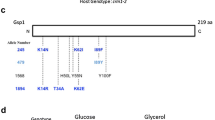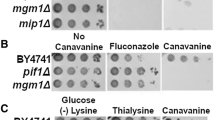Abstract
The yeast Saccharomyces cerevisiae has two isoforms of NADP+-dependent glutamate dehydrogenase (Gdh1 and Gdh3) that catalyze the synthesis of glutamate from α-ketoglutarate and NH4+. In the present study, we confirmed that Gdh3, but not Gdh1, mainly contributes to the oxidative stress resistance of stationary-phase cells and found evidence suggesting that the insignificance of Gdh1 to stress resistance is possibly resulted from conditional and reversible aggregation of Gdh1 into punctuate foci initiated in parallel with post-diauxic growth. Altered localization to the mitochondria or peroxisomes prevented Gdh1, which was originally localized in the cytoplasm, from stationary phase-specific aggregation, suggesting that some cytosolic factors are involved in the process of Gdh1 aggregation. Glucose starvation triggered the transition of the soluble form of Gdh1 into the insoluble aggregate form, which could be redissolved by replenishing glucose, without any requirement for protein synthesis. Mutational analysis showed that the N-terminal proximal region of Gdh1 (NTP1, aa 21–26, TLFEQH) is essential for glucose starvation-induced aggregation. We also found that the substitution of NTP1 with the corresponding region of Gdh3 (NTP3) significantly increased the contribution of the mutant Gdh1 to the stress resistance of stationary-phase cells. Thus, this suggests that NTP1 is responsible for the negligible role of Gdh1 in maintaining the oxidative stress resistance of stationary-phase cells and the stationary phase-specific stresssensitive phenotype of the mutants lacking Gdh3.
Similar content being viewed by others
References
Alberti, S. 2017. Phase separation in biology. Curr. Biol. 27, R1097–R1102.
Avendano, A., Deluna, A., Olivera, H., Valenzuela, L., and Gonzalez, A. 1997. GDH3 encodes a glutamate dehydrogenase isozyme, a previously unrecognized route for glutamate biosynthesis in Saccharomyces cerevisiae. J. Bacteriol. 179, 5594–5597.
Avendano, A., Riego, L., DeLuna, A., Aranda, C., Romero, G., Ishida, C., Vazquez-Acevedo, M., Rodarte, B., Recillas-Targa, F., Valenzuela, L., et al. 2005. Swi/SNF-GCN5-dependent chromatin remodelling determines induced expression of GDH3, one of the paralogous genes responsible for ammonium assimilation and glutamate biosynthesis in Saccharomyces cerevisiae. Mol. Microbiol. 57, 291–305.
Barral, Y. and Caudron, F. 2017. A droplet to sense sugar drops. Mol. Cell 68, 1017–1019.
Benjamin, P.M., Wu, J.I., Mitchell, A.P., and Magasanik, B. 1989. Three regulatory systems control expression of glutamine synthetase in Saccharomyces cerevisiae at the level of transcription. Mol. Gen. Genet. 217, 370–377.
DeLuna, A., Avendano, A., Riego, L., and Gonzalez, A. 2001. NADP-glutamate dehydrogenase isoenzymes of Saccharomyces cerevisiae. Purification, kinetic properties, and physiological roles. J. Biol. Chem. 276, 43775–43783.
Filetici, P., Martegani, M.P., Valenzuela, L., Gonzalez, A., and Ballario, P. 1996. Sequence of the GLT1 gene from Saccharomyces cerevisiae reveals the domain structure of yeast glutamate synthase. Yeast 12, 1359–1366.
Gou, K.M., Chang, C.C., Shen, Q.J., Sung, L.Y., and Liu, J.L. 2014. CTP synthase forms cytoophidia in the cytoplasm and nucleus. Exp. Cell Res. 323, 242–253.
Huang, Y., Wang, J.J., Ghosh, S., and Liu, J.L. 2017. Critical roles of CTP synthase N-terminal in cytoophidium assembly. Exp. Cell Res. 354, 122–133.
Hudson, R.C. and Daniel, R.M. 1993. L-Glutamate dehydrogenases: distribution, properties and mechanism. Comp. Biochem. Physiol. B 106, 767–792.
Ito, H., Fukuda, Y., Murata, K., and Kimura, A. 1983. Transformation of intact yeast cells treated with alkali cations. J. Bacteriol. 153, 163–168.
Lee, Y.J., Kim, K.J., Kang, H.Y., Kim, H.R., and Maeng, P.J. 2012. Involvement of GDH3-encoded NADP+-dependent glutamate dehydrogenase in yeast cell resistance to stress-induced apoptosis in stationary phase cells. J. Biol. Chem. 287, 44221–44233.
Moye, W.S., Amuro, N., Rao, J.K., and Zalkin, H. 1985. Nucleotide sequence of yeast GDH1 encoding nicotinamide adenine dinucleotide phosphate-dependent glutamate dehydrogenase. J. Biol. Chem. 260, 8502–8508.
Narayanaswamy, R., Levy, M., Tsechansky, M., Stovall, G.M., O’Connell, J.D., Mirrielees, J., Ellington, A.D., and Marcotte, E.M. 2009. Widespread reorganization of metabolic enzymes into reversible assemblies upon nutrient starvation. Proc. Natl. Acad. Sci. USA 106, 10147–10152.
O’Connell, J.D., Zhao, A., Ellington, A.D., and Marcotte, E.M. 2012. Dynamic reorganization of metabolic enzymes into intracellular bodies. Annu. Rev. Cell Dev. Biol. 28, 89–111.
Paz, I. and Choder, M. 2001. Eukaryotic translation initiation factor 4E-dependent translation is not essential for survival of starved yeast cells. J. Bacteriol. 183, 4477–4483.
Perlman, P.S. and Mahler, H.R. 1970. Intracellular localization of enzymes in yeast. Arch. Biochem. Biophys. 136, 245–259.
Petersen, M.C. and Trotter, P.J. 2011. Extramitochondrial localization of glutamate dehydrogenase isozymes in Saccharomyces cerevisiae. J. Young Investig. 22, 59–66.
Petrovska, I., Nuske, E., Munder, M.C., Kulasegaran, G., Malinovska, L., Kroschwald, S., Richter, D., Fahmy, K., Gibson, K., Verbavatz, J.M., et al. 2014. Filament formation by metabolic enzymes is a specific adaptation to an advanced state of cellular starvation. Elife 3, e02409.
Riego, L., Avendano, A., DeLuna, A., Rodriguez, E., and Gonzalez, A. 2002. GDH1 expression is regulated by GLN3, GCN4, and HAP4 under respiratory growth. Biochem. Biophys. Res. Commun. 293, 79–85.
Saad, S., Cereghetti, G., Feng, Y., Picotti, P., Peter, M., and Dechant, R. 2017. Reversible protein aggregation is a protective mechanism to ensure cell cycle restart after stress. Nat. Cell Biol. 19, 1202–1213.
Shen, Q.J., Kassim, H., Huang, Y., Li, H., Zhang, J., Li, G., Wang, P.Y., Yan, J., Ye, F., and Liu, J.L. 2016. Filamentation of metabolic enzymes in Saccharomyces cerevisiae. J. Genet. Genomics 43, 393–404.
Simpson-Lavy, K., Xu, T., Johnston, M., and Kupiec, M. 2017. The Std1 activator of the Snf1/AMPK kinase controls glucose response in yeast by a regulated protein aggregation. Mol. Cell 68, 1120–1133.
Acknowledgements
This work was supported by grants from Chungnam National University (2016). The authors thank Dr. J. Kim (Chungnam National University) for the plasmid pFA6a-GFP-kanMX6.
Author information
Authors and Affiliations
Corresponding author
Rights and permissions
About this article
Cite this article
Lee, W.H., Oh, J.Y. & Maeng, P.J. The NADP+-dependent glutamate dehydrogenase Gdh1 is subjected to glucose starvation-induced reversible aggregation that affects stress resistance in yeast. J Microbiol. 57, 884–892 (2019). https://doi.org/10.1007/s12275-019-9065-z
Received:
Revised:
Accepted:
Published:
Issue Date:
DOI: https://doi.org/10.1007/s12275-019-9065-z




